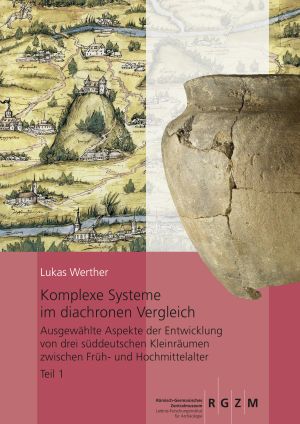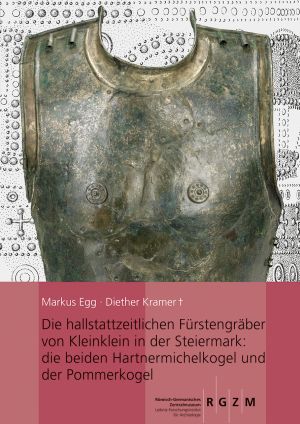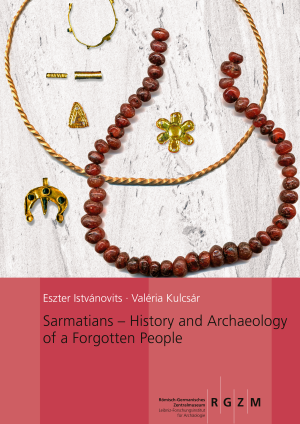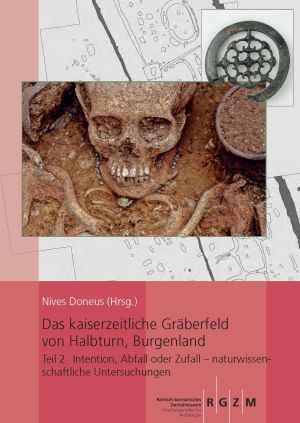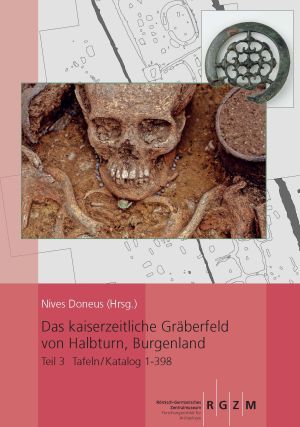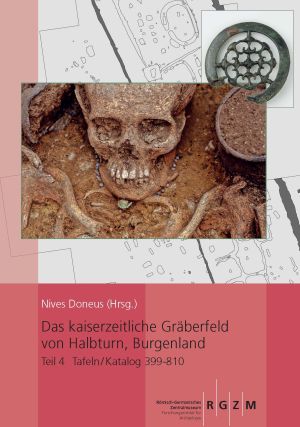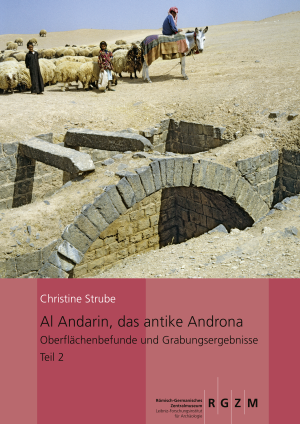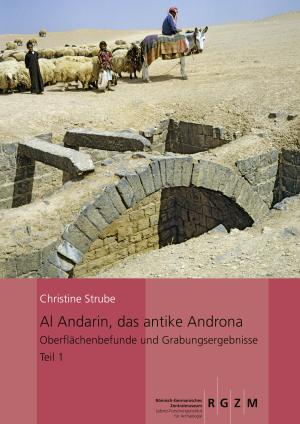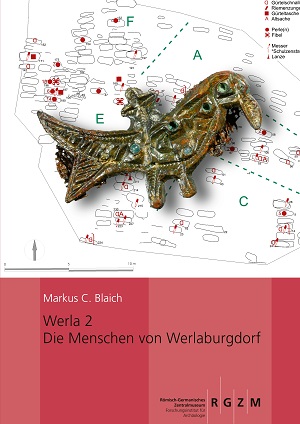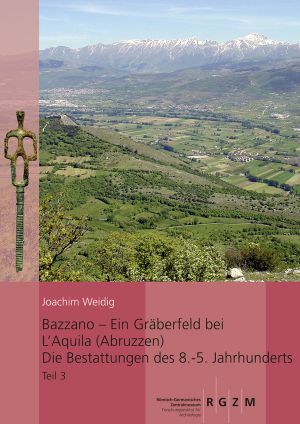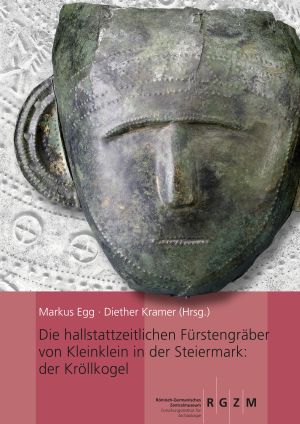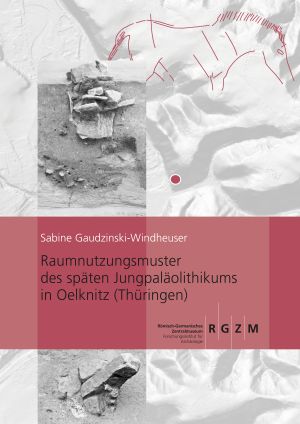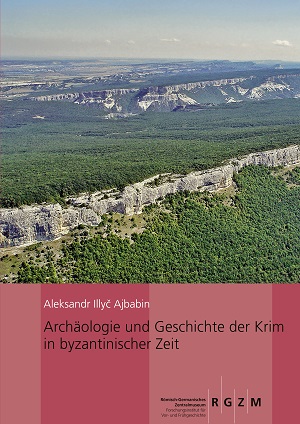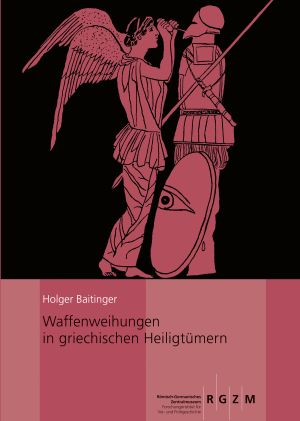Monographien des RGZM
In the Monograph series of the Romano-Germanic Central Museum, Leibniz Research Institute for Archaeology (RGZM), comprehensive studies on prehistoric and early medieval archaeology, history, culture and art are published, based on archaeological, historical and written ancient sources. Additional material and Open Data can be included in the online-version.
The digital content is planned to be enlarged by retrodigitalisation of older volumes.
Additional data on publications of this series
Italian translation of the texts from:
Joachim Weidig, Bazzano – ein Gräberfeld bei L’Aquila (Abruzzen). Die Bestattungen des 8.–5. Jahrhunderts v.Chr., Monographien des RGZM, Band 112 (Mainz 2014)
More publications of the Romano-Germanic Central Museum (RGZM)
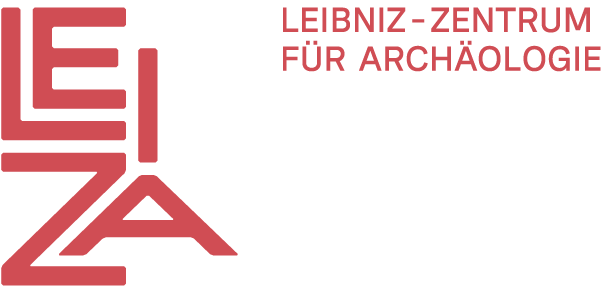
Press
Leibniz-Zentrum für Archäologie
Ludwig-Lindenschmit-Forum 1
D-55116 Mainz
Tel.: +49 6131 8885 0
E-mail: verlag@rgzm.de
Published so far
Komplexe Systeme im diachronen Vergleich: Ausgewählte Aspekte der Entwicklung von drei süddeutschen Kleinräumen zwischen Früh- und Hochmittelalter
Society and environment are complex systems in constant change. This study analyses the structural development of three small southern German regions between the 6th and 13th centuries. Based on archaeological, written and geoscientific sources, individual characteristics and supra-regional commonalities are worked out by a systematic diachronic comparison. Special attention is paid to the changes around the year 1000, a period in which the three micro-studies show a particularly pronounced individuality. Economic, ecological, social and political processes are discussed as causes of these region-specific special paths.
Ad Volume 2
Komplexe Systeme im diachronen Vergleich: Ausgewählte Aspekte der Entwicklung von drei süddeutschen Kleinräumen zwischen Früh- und Hochmittelalter
Society and the environment are complex systems that were also subject to constant change in the early and high Middle Ages. However, this process of change shows specific dynamics in different temporal phases and regions. This study analyses the structural development of three small southern German regions in Middle Franconia, Lower Franconia and Swabia between the 6th and 13th centuries on different levels. On the basis of archaeological sources, written evidence and geo-archives, individual peculiarities and supra-regional commonalities are worked out through a systematic diachronic comparison. Special attention is paid to the changes around the year 1000 and the Hungarian invasions as a possible triggering factor. Especially around the turn of the millennium, however, the three micro-studies reveal a particularly pronounced individuality. Economic processes, ecological crises and political-property and social upheavals are discussed as the causes of these region-specific special paths.
Ad Volume 1
Die hallstattzeitlichen Fürstengräber von Kleinklein in der Steiermark: die beiden Hartnermichelkogel und der Pommerkogel
After the new presentation of the Kröllkogel, the other three princely tombs of the Separatnekropole of Kleinklein were also to be reworked.
The graves show a clear chronological sequence: At the beginning is Hartnermichelkogel 1, where the founder of the Separatnekropole was buried in the last decades of the 8th century BC. The clearly younger Pommerkogel is likely to date between 660/650 and 630/620 BC. What is remarkable is that the grave furnishings are largely identical, which testifies to a fixed set of rules according to which the highest elite had to be buried in small graves over a period of 150 years. The construction of the separate necropolis thus suggests a clearly elevated position of this group of people as well as a pronounced dynastic consciousness.
Sarmatians – History and Archaeology of a Forgotten People
The book’s aim is to make a comprehensive introduction of the Sarmatians, the crucial people in the world of Iranian language speaking nomads.
The first part of the volume deals with the history and archaeology of these tribes starting from their emergence to the Hunnic invasion after which Iranian domination of the steppe belt was replaced by the power of Turkic nomads. Based on literary sources and archaeological material, the second part synthetises the history of the Sarmatians in the Carpathian Basin from the 1st to 5th century AD. A special emphasis is put on the steppe relations of the Alföld Sarmatians, innovations brought by new migration waves and, their impact on the autochthonous population. The third part is an outlook to the afterlife of the Sarmatians the traces of which stretch out from Britain to China.
Das kaiserzeitliche Gräberfeld von Halbturn, Burgenland: Teil 1: Archäologie, Geschichte, Grabbrauch
At that time, the Roman cemetery of Halbturn I belonged to the western part of Pannonia; the ancient city of Carnuntum was about 30 km away. The cemetery was completely investigated by systematic excavations, which is unusual for this region.
The finds show a great variability in burial customs, which can be seen in the positioning of the burials and the buried, as well as in the different efforts invested in the construction of the tombs. These characteristics depend, on the one hand, on the chronological period in question (2nd-5th century) and, on the other, on the personal status of the deceased (according to age at death, sex and physical disabilities). Particularly unusual are the numerous infant and child graves.
In addition to the archaeological-typological evaluation, the monograph offers important insights into life at the time: for example, a child's amulet is the oldest evidence of Jewish faith in Austria to date. Nutrition, diseases and injuries - whether caused by agricultural activities or domestic violence - are also described in detail, as well as considerations on animal breeding and husbandry, cultivated and wild plants, stone monuments, etc. Last but not least, the site, which was previously recorded by aerial archaeology, geophysical prospection and systematic field surveys, offers numerous further insights into the associated agricultural holdings.
Das kaiserzeitliche Gräberfeld von Halbturn, Burgenland: Teil 2: Intention, Abfall oder Zufall – naturwissenschaftliche Untersuchungen
At that time, the Roman cemetery of Halbturn I belonged to the western part of Pannonia; the ancient city of Carnuntum was about 30 km away. The cemetery was completely investigated by systematic excavations, which is unusual for this region.
The finds show a great variability in burial customs, which can be seen in the positioning of the burials and the buried, as well as in the different efforts invested in the construction of the tombs. These characteristics depend, on the one hand, on the chronological period in question (2nd-5th century) and, on the other, on the personal status of the deceased (according to age at death, sex and physical disabilities). Particularly unusual are the numerous infant and child graves.
In addition to the archaeological-typological evaluation, the monograph offers important insights into life at the time: for example, a child's amulet is the oldest evidence of Jewish faith in Austria to date. Nutrition, diseases and injuries - whether caused by agricultural activities or domestic violence - are also described in detail, as well as considerations on animal breeding and husbandry, cultivated and wild plants, stone monuments, etc. Last but not least, the site, which was previously recorded by aerial archaeology, geophysical prospection and systematic field surveys, offers numerous further insights into the associated agricultural holdings.
Das kaiserzeitliche Gräberfeld von Halbturn, Burgenland: Teil 3: Tafeln/Katalog 1-398
At that time, the Roman cemetery of Halbturn I belonged to the western part of Pannonia; the ancient city of Carnuntum was about 30 km away. The cemetery was completely investigated by systematic excavations, which is unusual for this region.
The finds show a great variability in burial customs, which can be seen in the positioning of the burials and the buried, as well as in the different efforts invested in the construction of the tombs. These characteristics depend, on the one hand, on the chronological period in question (2nd-5th century) and, on the other, on the personal status of the deceased (according to age at death, sex and physical disabilities). Particularly unusual are the numerous infant and child graves.
In addition to the archaeological-typological evaluation, the monograph offers important insights into life at the time: for example, a child's amulet is the oldest evidence of Jewish faith in Austria to date. Nutrition, diseases and injuries - whether caused by agricultural activities or domestic violence - are also described in detail, as well as considerations on animal breeding and husbandry, cultivated and wild plants, stone monuments, etc. Last but not least, the site, which was previously recorded by aerial archaeology, geophysical prospection and systematic field surveys, offers numerous further insights into the associated agricultural holdings.
Das kaiserzeitliche Gräberfeld von Halbturn, Burgenland: Teil 4: Tafeln/Katalog 399-810
At that time, the Roman cemetery of Halbturn I belonged to the western part of Pannonia; the ancient city of Carnuntum was about 30 km away. The cemetery was completely investigated by systematic excavations, which is unusual for this region.
The finds show a great variability in burial customs, which can be seen in the positioning of the burials and the buried, as well as in the different efforts invested in the construction of the tombs. These characteristics depend, on the one hand, on the chronological period in question (2nd-5th century) and, on the other, on the personal status of the deceased (according to age at death, sex and physical disabilities). Particularly unusual are the numerous infant and child graves.
In addition to the archaeological-typological evaluation, the monograph offers important insights into life at the time: for example, a child's amulet is the oldest evidence of Jewish faith in Austria to date. Nutrition, diseases and injuries - whether caused by agricultural activities or domestic violence - are also described in detail, as well as considerations on animal breeding and husbandry, cultivated and wild plants, stone monuments, etc. Last but not least, the site, which was previously recorded by aerial archaeology, geophysical prospection and systematic field surveys, offers numerous further insights into the associated agricultural holdings.
Al Andarin, das antike Androna: Oberflächenbefunde und Grabungsergebnisse: die Umfassungsmauer und das Kastron, Teil 2
Al Andarin, ancient Androna, with its two enclosing walls, ten churches, a public bath and a large military building (castron) covers an area of 155 ha and is thus one of the largest ruined sites in the water-scarce steppe areas of central Syria. As the first of about 300 settlements in these areas, Androna was investigated by excavations and surveys in 1997-2007.
The present results on the surface features, the castron (559 AD) and the wall rings not only make the history of Androna in the 5th-7th centuries AD tangible, they also paint an extremely vivid picture of the relationship between countryside and city in the Late Antique-Early Byzantine period.
s. Volume 1
Al Andarin, das antike Androna: Oberflächenbefunde und Grabungsergebnisse: die Umfassungsmauer und das Kastron, Teil 1
Al Andarin, ancient Androna, with its two enclosing walls, ten churches, a public bath and a large military building (castron) covers an area of 155 ha and is thus one of the largest ruined sites in the water-scarce steppe areas of central Syria. As the first of about 300 settlements in these areas, Androna was investigated by excavations and surveys in 1997-2007.
The present results on the surface features, the castron (559 AD) and the wall rings not only make the history of Androna in the 5th-7th centuries AD tangible, they also paint an extremely vivid picture of the relationship between countryside and city in the Late Antique-Early Byzantine period.
s. Volume 2
Die eisenzeitlichen Grabhügel von Vergina: Die Ausgrabungen von Photis Petsas 1960-1961
The village of Vergina stands on the ancient necropolis of Aigai, the first capital of the Macedonian Empire. With over 300 burial mounds still visible in the terrain, it dates from the early Iron Age (around 1000 BC) to the Hellenistic period (2nd century BC).
This volume presents for the first time the features and finds of the rescue excavations under the direction of Ph. Petsas in the course of road construction in 1960-1961. Together with the results of the systematic excavations by M. Andronikos, representative material is available to investigate the chronology, chorology and organisation of the necropolis and to enable statements to be made about Macedonian society in the early Iron Age.
Werla 2: Die Menschen von Werlaburgdorf: Ein Beitrag zur Geschichte des Nordharzvorlandes im 8. bis 10. Jahrhundert
For northern Germany, the period of Charlemagne's Saxon Wars (772-804) was one of the most violent upheavals in its history. Over the next two centuries, the Harz foothills were transformed from a military outpost into the heartland of Ottonian royal power. The coronation of Heinrich I (919) and the election of his son Otto the Great (936-973) as his successor marked the end of this transformation. However, it is difficult to trace the changes in Saxon society on the basis of the available accounts and documents.
For this reason, the cemetery of Werlaburgdorf, with its approximately 260 inhumations, deserves special attention. It is the largest necropolis of its kind in the Brunswick region and has been almost completely excavated. It was in use between the mid 8th and mid 10th centuries. The associated settlement probably comprised a maximum of five to seven families or farmsteads. The combination of anthropological research (including age structure, sex ratio, infant mortality and disease burden) and archaeological analysis allows further conclusions to be drawn about the internal structure of the burial community and the possible occupation of several areas.
The cemetery of Werlaburgdorf is located in the immediate vicinity of the Werla-Palatinate, which was first mentioned in 926 - the analysis of the cemetery from a supra-regional perspective offers a very special view of the Werla-Palatinate and the consequences of its establishment for the rural population.
Bazzano – ein Gräberfeld bei L’Aquila (Abruzzen): Die Bestattungen des 8.-5. Jahrhunderts v. Chr.
Bazzano near L'Aquila is one of the largest pre-Roman burial sites in Apennine Central Italy and even surpasses the necropolises of Fossa and Campovalano in the number of graves.
More than 500 burials of the Orientalising and Archaic period (8th-5th century BC) from the excavations of the Soprintendenza per i Beni Archeologici dell'Abruzzo from 1992-2004 are presented and analysed in this publication for the first time.
Above all, Etruscan pottery imports and their local adaptations enable a finer dating of the graves with their seemingly older traditional Italic decorative elements and weapons within an absolute chronology. In this way, the occupation sequence of the necropolis in four main phases, established on the basis of seriations and grave overlaps, can be better compared with the existing chronology systems.
In addition to questions on burial customs and social structures, the main part of the work is devoted to the classification and chronology of typical Middle Italian objects that are widespread far beyond Bazzano. With the complementary anthropological contributions, the picture of a mobile Iron Age population is sketched, which differed in its lifestyle from the individuals buried in the neighbouring necropolis of Fossa. Possibly this is due to a pronounced pastoral economy, transhumance or a very active warrior class, whose status is also emphasised by the high number of graves containing weapons.
Bazzano – ein Gräberfeld bei L’Aquila (Abruzzen): Die Bestattungen des 8.-5. Jahrhunderts v. Chr.
Bazzano near L'Aquila is one of the largest pre-Roman burial sites in Apennine Central Italy and even surpasses the necropolises of Fossa and Campovalano in the number of graves.
More than 500 burials of the Orientalising and Archaic period (8th-5th century BC) from the excavations of the Soprintendenza per i Beni Archeologici dell'Abruzzo from 1992-2004 are presented and analysed in this publication for the first time.
Above all, Etruscan pottery imports and their local adaptations enable a finer dating of the graves with their seemingly older traditional Italic decorative elements and weapons within an absolute chronology. In this way, the occupation sequence of the necropolis in four main phases, established on the basis of seriations and grave overlaps, can be better compared with the existing chronology systems.
In addition to questions on burial customs and social structures, the main part of the work is devoted to the classification and chronology of typical Middle Italian objects that are widespread far beyond Bazzano. With the complementary anthropological contributions, the picture of a mobile Iron Age population is sketched, which differed in its lifestyle from the individuals buried in the neighbouring necropolis of Fossa. Possibly this is due to a pronounced pastoral economy, transhumance or a very active warrior class, whose status is also emphasised by the high number of graves containing weapons.
Bazzano – ein Gräberfeld bei L’Aquila (Abruzzen): Die Bestattungen des 8.-5. Jahrhunderts v. Chr.
Bazzano near L'Aquila is one of the largest pre-Roman burial sites in Apennine Central Italy and even surpasses the necropolises of Fossa and Campovalano in the number of graves.
More than 500 burials of the Orientalising and Archaic period (8th-5th century BC) from the excavations of the Soprintendenza per i Beni Archeologici dell'Abruzzo from 1992-2004 are presented and analysed in this publication for the first time.
Above all, Etruscan pottery imports and their local adaptations enable a finer dating of the graves with their seemingly older traditional Italic decorative elements and weapons within an absolute chronology. In this way, the occupation sequence of the necropolis in four main phases, established on the basis of seriations and grave overlaps, can be better compared with the existing chronology systems.
In addition to questions on burial customs and social structures, the main part of the work is devoted to the classification and chronology of typical Middle Italian objects that are widespread far beyond Bazzano. With the complementary anthropological contributions, the picture of a mobile Iron Age population is sketched, which differed in its lifestyle from the individuals buried in the neighbouring necropolis of Fossa. Possibly this is due to a pronounced pastoral economy, transhumance or a very active warrior class, whose status is also emphasised by the high number of graves containing weapons.
Die hallstattzeitlichen Fürstengräber von Kleinklein in der Steiermark: der Kröllkogel
The sites around the Burgstallkogel between Großklein and Gleinstätten in western Styria are among the most outstanding of the Early Iron Age in Austria and Central Europe. The centre is the hilltop settlement on the Burgstallkogel, at the foot of which lies the Sulmtal necropolis, with some 700 burial mounds still standing.
On the first river terrace of the Saggau valley, near Kleinklein, the four richest princely burials of the entire eastern Hallstatt district were found. Most of the finds were made in the 19th and early 20th centuries. A successful re-excavation in 1995 in the most recent princely tomb, the so-called Kröllkogel, provided the impetus for the present new treatment and re-evaluation of this magnificent tomb. To achieve this goal, the Joanneum Universal Museum in Graz and the RGZM joined forces and organised an interdisciplinary group of researchers to examine all aspects of the find.
Antike Tuffbergwerke am Laacher See-Vulkan
With the tuff mines around the Laacher See volcano, we grasp the roots of the building stone industry in Central Europe. It was the master builders who came from the Mediterranean region as part of the Augustan expansion and urbanisation policy who brought the knowledge of stone architecture to our region. Quarried in extensive tunnel systems, the valuable stone was used from the beginning for the construction of representative large-scale buildings. Eloquent evidence of this is the so-called Ubier Monument in Cologne, the oldest stone building in Roman Germany. As an early export hit, tuff was the first "lightweight building stone" and a sought-after building material on ancient and medieval large-scale construction sites. Based on this 2000-year tradition, the tuff industry is still an important economic factor in the region today.
In the book, the 59 known ancient mines are described in detail, as are the techniques used to extract and process stone. The unusually good sources also allow a well-founded assessment of the yield of the deposits. Research on the numerous quarry and consecration inscriptions sheds new light on the sanctuaries in tuff mining and provides insight into the religious imagination of the people working there. A detailed study by Lutz Grunwald on the pottery from the mines led to a completely new assessment of the medieval mining activities.
Raumnutzungsmuster des späten Jungpaläolithikums in Oelknitz (Thüringen)
In discussions on the evolution of human behaviour, the question of how humans moved in space plays a crucial role. The earliest evidence of behavioural patterns that can be interpreted in this sense comes from the transition from the Middle to the Upper Palaeolithic.
The Thuringian site of Oelknitz represents one of the most important testimonies to early social systems, which become visible as early as about 15000 years ago. The analysis of this site is able to show the variability of settlement systems in the late Upper Palaeolithic and to contribute to a much more complex understanding of settlement systems, despite the worldwide scarcity of such excellently preserved findings.
Grabbauten in den nördlichen Grenzprovinzen des Römischen Reiches zwischen Britannien und dem Schwarzen Meer, 1.-3. Jahrhundert n. Chr.
Burial structures served not only to commemorate a person, but also to represent the family. The adoption or transformation of Roman status symbols by indigenous people in the provinces is therefore a measure of romanisation. The adaptation of Mediterranean forms can mean a break with indigenous traditions or - on the contrary - in certain selections be an instrument to communicate traditional values and patterns in a contemporary presentational framework.
The study shows where the models came from, which social groups conveyed them and which took them up and even developed them further. Monument topography and architectural types are taken into account as well as the media of epitaphs and sculpture. The differences between the Rhine and Danube provinces are revealing.
Grabbauten in den nördlichen Grenzprovinzen des Römischen Reiches zwischen Britannien und dem Schwarzen Meer, 1.-3. Jahrhundert n. Chr.
Burial structures served not only to commemorate a person, but also to represent the family. The adoption or transformation of Roman status symbols by indigenous people in the provinces is therefore a measure of romanisation. The adaptation of Mediterranean forms can mean a break with indigenous traditions or - on the contrary - in certain selections be an instrument to communicate traditional values and patterns in a contemporary presentational framework.
The study shows where the models came from, which social groups conveyed them and which took them up and even developed them further. Monument topography and architectural types are taken into account as well as the media of epitaphs and sculpture. The differences between the Rhine and Danube provinces are revealing.
Archäologie und Geschichte der Krim in byzantinischer Zeit
Although the archaeology and history of the Byzantine Crimea is a well-researched subject, the results of this research have received little attention outside the Russian-speaking world.
This monograph by the internationally renowned archaeologist Aleksandr I. Ajbabin, the result of a joint project between the RGZM and the Ukrainian Academy of Sciences, is intended to help raise awareness of this region, which was essentially characterised by the tense relationship between the steppe peoples and the Byzantine Empire.
This thoroughly revised and expanded translation of the work, which was first published in Russian in 1999, provides the German public with a comprehensive overview of the find material and its chronology, some of which is difficult to access.
Akteure und Organisation der Handelsschifffahrt in den nordwestlichen Provinzen des Römischen Reiches
In ancient times, goods were transported by water whenever possible - including in the northern provinces of the Roman Empire, which were surrounded by the Mediterranean, Atlantic and North Sea. Here, a dense network of rivers offered ideal conditions for inland shipping.
We know a number of players in merchant shipping from inscriptions. In the northern provinces, these were mainly shipowners who referred to themselves as nauta inland and navicularius on the Gallic Mediterranean coast. The Gallic navicularii were also involved in transporting supplies to the capital Rome in the western Mediterranean. Based on the inscriptions, this study examines the professional groups involved in merchant shipping and their associations.
Latènezeitliche Mühlen aus dem Gebiet zwischen den Steinbruchrevieren Mayen und Lovosice
Mills produced in the quarry areas around Mayen and Lovosice were highly sought after in the Latène period due to their high quality. Again and again they appear in unexpectedly distant settlements. The region in between therefore lends itself to reconstructing the economic spheres of influence of both quarries.
By documenting as many mills as possible in this area and using petrographic analyses, it is possible to characterise these important quarries and identify other previously unknown sources. For the first time, sales areas and economic structures are documented in terms of cultural history and natural science. In addition to explanations of production, operation and utilisation, a compilation of the oldest mills in western Europe and the question of their inventors round off the study.
Waffenweihungen in griechischen Heiligtümern
During excavations in important Greek sanctuaries such as Olympia or Delphi, large quantities of weapons and pieces of armour from the 8th to 4th century BC were found. They are considered to be pieces of booty that Greek city states donated to the gods after victorious battles.
In this volume, the custom of dedicating weapons in the Greek world between Sicily and Cyprus is summarised. More than 130 sanctuaries with weapon finds form the basis of the analysis, which also includes written and epigraphic sources. This makes the volume a comprehensive compendium of an important votive custom in ancient Greece.
Die Verbreitung von Terra Sigillata aus den Manufakturen von Arezzo, Pisa, Lyon und La Graufesenque: Die Transformation der italischen Sigillata-Herstellung in Gallien
In the last decades of the 1st century B.C., some of the major producers of sigillata in Arezzo set up branches in Gaul to serve the local market. These soon drove the parent companies out of business. This process is documented by 230 distribution maps.
The branches in Gaul are presented in the context of the development of economic centres. They led to a transformation of this originally Italic industry, which was also reflected in a change in the legal status of potters and potteries in Gaul. In addition, transport costs were determined using GIS applications and visualised on maps. Dated sites allow a chronological categorisation of the potters discussed.



